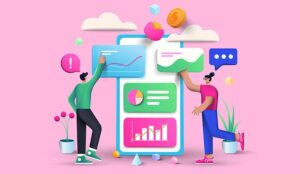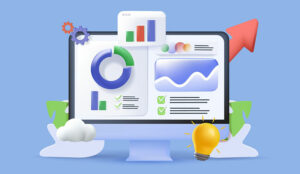To survive in today’s competitive landscape, companies need to be sure that their employees are performing at their best, delivering amazing experiences to customers. After all, the estimated cost of US customers switching products due to a bad experience is around $1.6 trillion.
Unfortunately, in today’s digital age, it’s becoming increasingly difficult to track, monitor, and manage both customer experience and employee performance at the same time.
With clients reaching out on more channels than ever before and team members distributed around the globe, how do you ensure you have the right end-to-end view?
Call centre dashboards are the answer.
Here’s your guide to call centre dashboards and their ability to transform the contact centre as we know it.
What is a Call Centre Dashboard?
A call centre dashboard is a behind-the-scenes view of your contact centre operations, built to provide better insights into customer and agent experience. Dashboards showcase call centre metrics and KPIs, allowing managers and their employees to monitor and enhance their performance.
Often, dashboards come with a simple, visual display, which makes it easier to instantly pinpoint issues that need to be improved. You can even set your dashboard or wallboard up to match the needs of your company, by choosing which metrics you want to display.
A call centre dashboard provides instant access to essential information about the contact centre. Through graphs, charts, notifications, and statistics, you get everything you need to identify the strengths and weaknesses of your organization. Essentially, it’s a dynamic map to success.
Dashboards take the complexity of call centre analytics and transform data into a simple, consumable format, so you can simultaneously inspire your agents and inform your supervisors.
The best dashboards features:
- Intelligent data integration to combine multiple sources
- Real-time reporting and notifications
- Flexible deployment options (on-premises, hybrid, and cloud)
- Out-of-the-box connectors
- Agent dashboards for motivation
- Supervisor or manager dashboards
- Calendar integrations
- Motivational messaging
What are the Benefits of Call Centre Dashboards?
Managing a successful contact centre means keeping your finger on the pulse of the current performance of your team, and the metrics that your team is achieving. A call centre dashboard software solution helps with this.
You can track information that helps you to reduce call handling time, meet service level agreements, and improve customer satisfaction.
With the right dashboard, you can:
Improve Customer Experience:
Call centre reporting shows you where you need to make changes to improve customer satisfaction. You can determine which actions lead to churn and create your own customer satisfaction dashboard for tracking things like customer sentiment, and risk level.
Keeping an eye on things like CSAT scores, call handling and waiting times, and first-time resolution can make a huge difference to your customers.
Enhance Team Engagement:
Particularly now, in the age of remote work, dashboards have a significant impact on agent experience. The right tools will guide your employees by showing them where they need to improve in real-time.
Notifications and motivational messages keep teams inspired, while dashboard visuals ensure team members are keeping up with their peers. You could even use gamification to create competitions for hybrid teams.
Improve Agent Performance:
Call centres are constantly striving to improve the performance and efficiency of their teams. However, it’s difficult to know where extra training and guidance might be necessary.
Supervisors with access to real-time information can jump in on a call with barge-in and whisper functions to stop an agent from losing an opportunity in the moment. Dashboards also provide insights into areas where your employees might need further support.
Better Business Decision-Making:
How do you know whether you should be increasing the amount of time your employees spend in the chat landscape, or on the phone? Your call centre metrics dashboard will show you when human voice is essential, and when peaks in demand might occur on other channels.
These in-depth analytics ensure that you’re choosing the right staffing strategies and investing in the correct tools for growth.
Improve and Optimize With Time:
A call centre dashboard doesn’t just give you information in the moment. The right technology will also help you to keep track of trends in customer experience that you need to respond to. Using your dashboard, you’ll be able to watch your company grow and improve its customer service strategy with time.
How Do You Choose a Good Call Centre Dashboard?
call centre dashboards come in many shapes and sizes, depending on the business and its needs. Although all companies have their own distinct requirements, there are some features you should be looking for in any call centre dashboard software.
Here’s what you need to consider when investing in call centre metrics, analytics, and reporting:
1. Ease of Use and Customization
Call centre dashboard software turns your operational data and real-time metrics into easily accessible information for the entire workforce.
The dashboard you choose should be simple enough to understand, with plenty of visualizations that can deliver quick insights to employees in the moment. Choose a dashboard software that has an easy-to-use content editor.
To ensure the best possible experience for your agents, make sure your call centre dashboards are:
- Versatile: In the age of digital transformation, agents will be examining call centre metrics from a range of devices – including desktops and tablets. Your dashboards should be visible and easy to read from any device.
- Adaptable: The dashboard metrics most important to your team might change depending on the situation, or your company. Your software solution should come with customizable components which allow you to choose which metrics you want to track, what kind of notifications you need to send, and even how to set up automated alerts.
- Comprehensive: A great call centre dashboard makes it easy to connect information and analytics from a range of different environments in one space. If you’re running an omnichannel contact centre, you should be able to link information from every channel into the same aligned view.
Ideally, you should also be able to customize the dashboards your agents and managers see with things like thresh-hold based alerting, which alerts agents when conditions are changing in real-time, and scrolling marquee text that doesn’t take up too much retail space but provides them with handy information.
2. Comprehensive Business Insights
The main benefit of a call centre dashboard is its ability to provide companies with real-time and historical metrics, which generate positive change. Before you invest in a dashboard solution, you’ll need to ensure that your chosen software can provide the insights you need into various areas. Some of the major segments you’ll need to think about include:
- Performance indicators: contact centre performance indicators provide insights into how your call centre is operating at any given time. You can check which hours have the most activity, helping you to plan for peaks in demand, and you can evaluate any issues with call quality or dropped data that might have an impact on customer experience.
- Agent performance indicators: These are the metrics that show how productive your remote and in-office employees are being. The right metrics, such as average talk time, call count, average waiting time, and so on can help you to see which of your team members at the top performers, and which might need additional help.
- Real-time alerts: Real-time alerts are notifications that inform managers and supervisors in the contact centre when something is going wrong. If a customer’s sentiment level drops drastically, or an agent appears to be encountering an issue, then a supervisor can be informed immediately to rectify the problem.
- Call centre trends: These metrics cover larger overall trends in the contact centre, such as how long the average customer has to wait to get a response on an average day, and how long they spend on the phone. You can also track trends like first-time resolution, and how often your agents need to pass a customer to another employee.
3. Seamless Integrations and In-Depth Analytics
As mentioned above, the best insights from call centre dashboard software emerge when contact centre leaders can connect as many valuable sources of information as possible.
You should be able to link information from your IVR, ACD, and other tools, including CRMs like Microsoft Dynamics and Salesforce. The more connected your system is, the better.
In some cases, you’ll even be able to simplify the agent experience even more by bringing your contact centre and wallboard technology into a platform they already use, like Microsoft Teams.
As Microsoft Teams becomes increasingly crucial in the business ecosystem, it’s also attracting the attention of companies who want to enhance their contact centre too.
Using the “Connect” model, experienced Microsoft partners can use SBC routing to bring the contact centre calls into Microsoft Teams, and route each conversation to the correct agent.
All customer profiles and context can be provided to agents at the same time, and CRM data can pop up to provide them with instant access to information on previous purchases.
Supervisors will even be able to view their reports in Power BI, keeping the whole system connected in a Microsoft-focused ecosystem.
Using Dashboards for Better Call Centre Analytics
A call centre dashboard is a powerful tool in business performance optimization.
With the right software, you can inspire your team, track important information, and even use call centre management reports to help align your hybrid employees. So, how do you make sure you’re enhancing your call centre reporting strategy with dashboards?
Start by:
1. Setting Your Goals
Decide early what you want to accomplish with your call centre dashboards. Are you trying to determine which new tools you should be investing in for the modern contact centre, like omnichannel integrations and sentiment analysis? Are you using your dashboards to keep hybrid and remote employees engaged and informed wherever they are?
Setting goals will show you which metrics you need to focus on the most to determine whether you’re making any genuine improvements. Some of the questions you could ask to set your goals to include:
- How responsive are our agents, and can we improve this?
- How efficient is our customer service environment, and how satisfied are customers?
- How engaged and efficient are our remote workers?
- Do we know which agents need the most training and guidance?
- Which channels should we be assigning more agents to?
2. Make the Data Accessible
Once you’ve set your goals, you should have a decent idea of the kind of metrics you’ll need to track. For instance, if you’re looking to find out how efficient your agents are in a new hybrid environment, you might need to keep an eye on things like call volume trends, call handling time, first call resolution, and first response time.
If you’re tracking the performance of your agents in dealing with new service channels, you might need to look at things like average wait time, call handling time and support costs vs revenue.
Your dashboard should allow you to align your metrics into visual insights that you can provide to your agents and team leaders to keep them on the right track.
Ensure the data you provide is as accessible as possible, so employees can respond to it straight away. For instance, rather than just showing your team their performance on a graph when it comes to response rate, use color to show them when they’re dropping below the benchmark (red), or achieving great results (green).
3. Support Your Agents
If you’ve taken the time to choose the right call centre dashboard, you should be able to onboard team members and leaders quite quickly. Choosing to combine your Microsoft Teams contact centre, UCaaS tools, and dashboards in the same environment will make adoption even easier.
However, there are likely to be team members that still need assistance in getting used to their new call centre metrics dashboard and how to use it.
Providing some initial training on what each of the dashboard features can do, and where employees can go to get additional help will ensure that everyone’s on the same page when it comes to pursuing better business results. This will be particularly important if you’re tracking a lot of different metrics at the same time.
Supervisors and team leaders should also receive additional training on how to make the most of their new technology.
These employees might need to know how to add new metric-tracking modules into the dashboard and roll them out to everyone at the same time. They could also need information on how to turn call centre reporting details into predictive analytics.
Looking into long-term customer and employee trends can help business leaders to determine when peaks in demand might occur, as well as where employees might need extra help.
Remember the Feedback Loop
One final tip for anyone planning on using a call centre dashboard is that it’s always valuable to encourage feedback as much as you can from your agents and team leaders. The best way to evaluate the performance of any new software is to pay attention to how your employees respond to it.
Feedback from your employees can work alongside other insights and metrics to tell you which parts of your dashboard strategy may need to change.
Remember to consider:
- Reviews and input from employees: Ask your team members how they feel using the new wallboard or dashboard technology, and make sure they have a way to share concerns about any features that may seem too complicated.
- Performance and engagement metrics: If your dashboard is doing its job to motivate and guide employees, the metrics you measure around engagement, productivity, and efficiency should be improving with time.
- Customer reviews and feedback: If your customers start to deliver more positive feedback, or your NPS score goes up, this is a good sign that your dashboard technology is generating the right outcomes.
- Insights from team leaders: Pay attention to your team leaders and the requests they make. They may be able to make suggestions about which metrics they’d like more information about, or which automated alerts need to be set up.
Discover the Benefits of Call Centre Dashboards
call centre dashboards provide companies of all sizes with the valuable information they need to grow, improve, and even empower the modern workforce.
With the right call centre dashboard software, teams can watch and manage their own performance wherever they are, ensuring they never fall behind their peers in productivity and efficiency.
The correct solutions will also give managers and supervisors the tools they need to properly support their teams, in an environment where distributed workforces are becoming more common.
Knowledge is power in any contact centre, and today, there’s more information to keep track of than ever before. A call centre dashboard could be the key to understanding what it really takes to delight your audience and outshine the competition.
Author: Guest Author
Published On: 19th Jul 2022
Read more about - Guest Blogs, Geomant



































